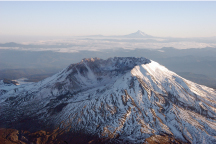
Mount St. Helens in Washington state is an active
volcano in the Cascade Range. (“Mount St. Helens, Washington:
Crater, Dome, and Eruption Images” United States Geological Survey.
http://vulcan.wr.usgs.gov/Imgs/Jpg/MSH/MSH05/MSH05_aerial_st_helens_from_NW_with_hood_11-23-05.jpg)
|
|
Where the Sierra Nevadas end, a chain of explosive volcanic
centers begins, known as the Cascade volcanoes. The Cascades region
forms an arc-shaped band extending from British Columbia to northern
California, roughly parallel to the Pacific coastline. Within this
region, thirteen major volcanic centers lie in sequence like a
string of explosive pearls. Although the largest volcanoes, such as
Mount St. Helens, get the most attention, the Cascade Range is
really made up of a band of thousands of very small, short-lived
volcanoes that have built a platform of lava and volcanic debris.
Rising above this volcanic platform are a few strikingly large
volcanoes that dominate the landscape.
The Cascades volcanoes define the Pacific Northwest section of the
“Ring of Fire,” a fiery array of volcanoes that rim the Pacific
Ocean. As if volcanic hazards were not enough, the Ring of Fire is
also infamous for its frequent earthquakes. In order to understand
the origins of this concentrated band of Earth's hazards, we have to
take a peek beneath our feet.
Beneath the Cascades, a dense oceanic plate plunges beneath the
North American Plate in a process known as subduction. As the
oceanic slab sinks deep into the earth's interior beneath the
continental plate, high temperatures and pressures allow water
molecules locked in the minerals of solid rock to escape. The water
vapor rises into the pliable mantle above the sinking plate, causing
some of the mantle to melt into magma. This newly formed magma rises
toward the earth's surface and erupts, forming a chain of volcanoes
(the Cascade Range) above the subduction zone. Are there more
eruptions in our future? As long as subduction continues, new
Cascade volcanoes will continue to rise.1
|



